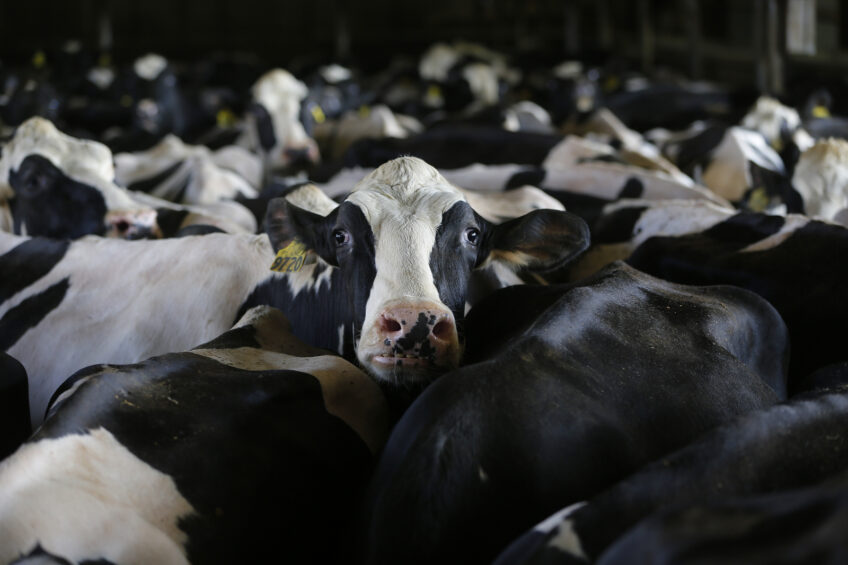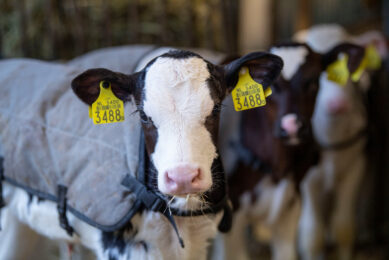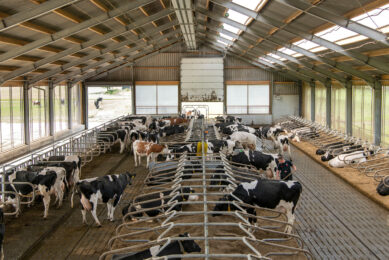Family farm XXL

No less than 11 members of the Larson family run Larson Acres dairy farm in the American town of Evansville, Wisconsin. With about 2900 dairy cows, 5000 acres of land and 50 employees clear tasking and good management is key to the success of the whole operation.
The proverbial ‘nerve centre’ of the Larson Acres dairy operation lies in the large conference room in the office building a good walk away from the barns. An oval table is surrounded by 12 chairs, one for each family member and one for the herd manager. General manager Mike Larson (51) comfortably sits down at the head of the table. He divided the different parts of the operation between the family members, each has its own area of responsibility and employees, from milking to manure, and young animal care to overall employee management. “One needs good people to start with, but to get there, people management skills are essential, as are good pay and good treatment,” Mike Larson confirms. Many dairy farmers don’t know how to manage personnel, let alone manage family members. That can be a serious downfall. Larson: “Communication is key.”
The current general manager is part of the 5th generation which took over the farm in 1990. At that time the farm had 150 head of cattle, housed in a tie stall barn. “We sat down with our brothers and sisters, nieces and nephews and came to the conclusion that all of us wanted a future in dairy farming. As a result we laid out a strategic expansion plan to ensure that we all could get a decent income out of the business.” The first step was a growth to 600 cows in 1998, 1200 in 2005 and 2400 today, excluding 500 dry cows. The most recent growth of the herd to 2900 animals demanded the construction of a whole new barn. This is a staggering 400 meters long and 80 meters wide, has eight rows of cubicles and three feed alleys. Growth isn’t for free. Mike: “About 25% of the current value of the business is mortgaged, even in times of really strong milk prices a doubling of the farms cannot be paid for out of our cash flow alone.”
Peace and regularity
The newest barn is fitted out with cross ventilation, which gives a continuous airflow of about 10 kilometres an hour over the cows. In summer a pad cool system on the inlet side guarantees a comfortable cool climate. The airspeed also does away with any potential fly problems, because they don’t like draft. Structural baffles from the ceiling of about 2.5 meters in height prevent too high airspeeds. The new barn design and cow traffic is all about peace and regularity. Only if a minimum of 50% of all cows at a certain time are resting and ruminating the farm managers are satisfied. Walk through the barn at a random time and the only noise to be heard is the slight humming sound of the ventilators. Cows are quiet and happy in stable groups. There are two main groups, a group of cows in their first lactation and the rest. Young animals stay in groups of maximum 160 cows for the first 45 days, before they are moved to the main group. That gives them the time to get used to the walk to the milking parlour three times a day. After 45 days in a relatively small group, they feel more comfortable in a much larger group waiting for their turn in the parlour.
At Larson Acres there are two milking parlours in use, where employees milk in three shifts, 24 hours a day. The newest parlour consists of a double 24 rapid exit, connected to the two older barns is a double 22 parlour. Per shift three Mexican milkers are at work, two of them are in the pit and a third manages cow traffic and relieves one of the others every 45 minutes. The milking crew is hand-picked. Meticulousness udder cleaning, pre- and postdip of the teats pays for itself in better milk quality, however every second that a milker spends on a cow has a cost side as well. With 2400 cows that walk through the milking parlour three times a day, one second extra spent per cow will result in two hours extra work.
At Larsons there is no dedicated milk storage. From the milking parlours the milk is piped through a cooler and pumped directly into the trailer of the milk processor. Every day 6 truckloads leave the yard, each carrying up to 25,000 litres of milk. The average production per cow is 44.5 kilos, the production per year is 14500 kilos with 3.8% fat and 3.2% protein. Cell count is about 140,000 due to good preparation and wash. Average lactation time is 170 days.
Calf care
Without calves there will be no milk production. Every day employees of Larsons assist at eight or nine births, dry cows are monitored every hour of the day and separated immediately when in labour. All heifers are genetically tested and if they qualify they will be inseminated with sexed semen. The goal is to improve the herd as much as possible from their own stock. Cows that don’t fit the profile are bred to Angus bulls, because these calves are very sellable at good prices for meat production. Eventually the cows with a sub optimal profile are sold too. For replacement the operation needs about 3000 heifers per year, including sell offs and trade of genetically valuable stock within the breeding farm branch of the Larson Acres operation. Larson Acres is a fully closed farm with no animals coming from anywhere else but their own rearing operation. On average the cows stay for 4.2 lactations on the farm, however this time is under pressure. High beef prices and low cost to raise heifers makes replacement a more viable option.
If the management of Larson understands one thing, it is that the calves are the future. Calf care has top priority and they are proud of it. Within an hour after birth, when the calves are dried up, they are separated from the cow. Employees make sure the calves get the first 4 litres of colostrum and disinfect the navel. The cow is checked for mastitis, gets a calcium tablet to help prevent milk fever and is added to the fresh cow group.
The calves are housed in one of four calf barns. These building are designed to be kept ultra clean, as is the calf housing system inside. After weaning the last calves, the whole building is cleaned and disinfected. After the colostrum the calves are fed a ration of pasteurised milk and water, and from day three onwards concentrated feed is introduced. After seven weeks the individual cubicles are reset to duo housing. The hygienic environment and dedicated employees to look after the young animals from feeding the first colostrum to carefully introducing concentrate and roughage results in a dead loss percentage of only 0.25%.
At eight weeks of age the calves are moved to a group housing system with 10 animals per pen, until they reach four months old. They are kept on a ration of TMR and additional concentrated feed. The goal is to create an uniform herd, which reaches breeding size at 14 months. For that Larson aims for the combination of height and weight, 1.2 meters and 350 kilos and a loss of 1.5%. They try to win at least one month compared to the average in North America. Mike Larson: “Apart from a veterinarian that spends at least two hours a week doing regular health checks our employees are trained on the job and work with strict protocols. That said, we empower our personnel to make their own decisions. As management we want everyone to know they are part of the success of Larson Acres and prevent micromanagement.”
College graduate
During a walk around the 25 hectare measuring yard it is advisable to keep your eyes open. With some 2900 cows to feed and 4 barns with young animals to take care of, the feed truck driver has to put his foot down. A cloud of dust in the distance most of the time means that one has to step aside. Feed out happens at lightning speeds and in large quantities. However, that doesn’t mean that there is room for slack. All rations are carefully formulated and put together, measured by weight and/or quantity. Even the seemingly simple task of ‘feed truck driver’ is carried out by a college graduate. He has the responsibility of adjusting the feed formula according to the quality of raw materials and the evaluation of the structure of the leftovers from the previous feed run.
All silage is weighted. The trucks are connected to a computer that tells the driver what the dry matter content is and how to adjust the raw materials to reach the optimum. At Larson Acres all corn, alfalfa and grass is grown in their own fields. Concentrate and loose protein components are bought from the feed mill. All feed is mixed into the TMR, mixing time is only three minutes to prevent the destruction of fibre. Good fibre content benefits rumination and prevents rumen acidosis and lots of secondary problems caused by subclinical acidosis.
Manure management
An often underestimated but ultimately a very important aspect of a large dairy operation is manure management. General managers Mike and his brother Ed have a full time job in taking care of the manure side of the business. In the first step sand is removed from the manure and dried for re-use, the barn floor is scraped three times a day. Then the solids are taken out and sold for composting. The liquid remains are pumped into a huge 18 million gallon big lagoon. After harvest most of the liquid manure is pumped via a piping system to the fields were it is then knifed in by a tractor using a tow line system. For fields further away, transportation via trucks is contracted.
State laws specify that a farm has to prevent nitrate from entering the aquifer and Larson benefits by optimal use of the manure on its own land as well. All equipment is fitted with a GPS system. The harvest yield is monitored, the needs of the land are mapped and accordingly the optimal amount of manure is applied. Mike: “In our business it is all about efficiency. When it comes to reduction of costs it is not about spending less money, but it is all about spending money on the right things and where it makes a difference.” For the near future the general manager isn’t planning further expansion, but the optimisation of production and upping the production per cow through genetics. Mike: “I expect dairy to be strong for the time to come, still 10% of milk needed for Wisconsin cheese is still imported. Our operation has the ideal scope for the site it is located. In 5 to 15 years we will hand it over to the sixth generation, who are now in their forties.”
Join 13,000+ subscribers
Subscribe to our newsletter to stay updated about all the need-to-know content in the dairy sector, two times a week.




























